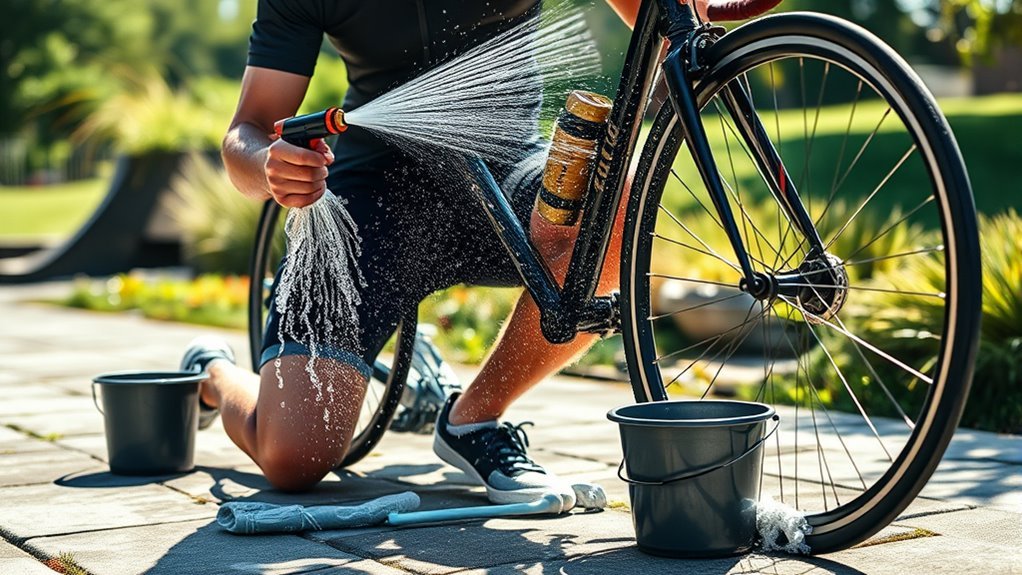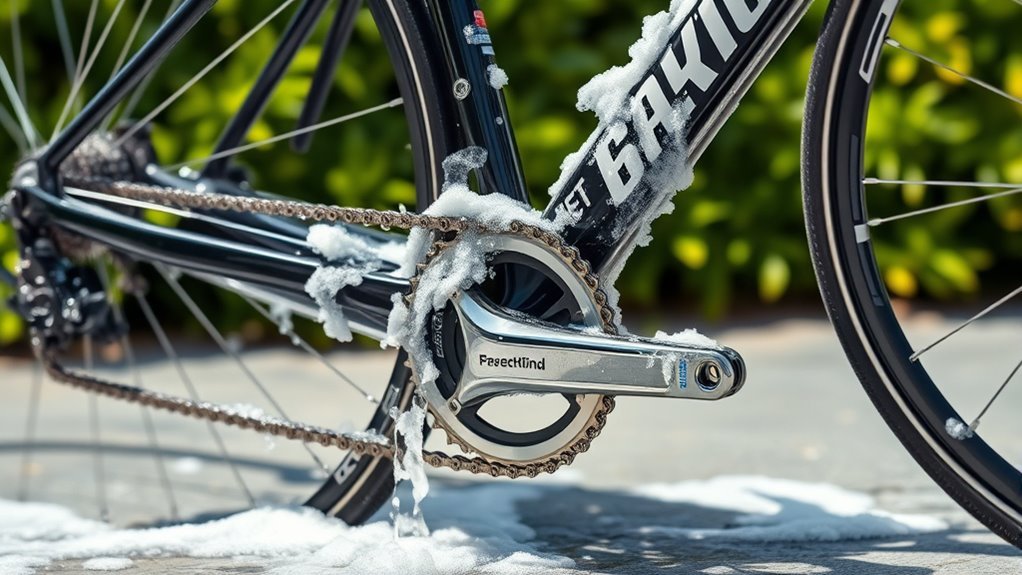Washing Bike Without Damage
You can wash your bike without damage by using eco-friendly, bike-specific cleaners and soft brushes or microfiber cloths to protect finishes. Avoid high-pressure water sprays; instead, use lukewarm water at a gentle spray distance to prevent water intrusion into bearings or seals. Remove accessories and cover sensitive parts before cleaning. After washing, dry thoroughly with absorbent towels and apply lubricant sparingly on the drivetrain. Following these steps maintains your bike’s performance and longevity, with more in-depth techniques to explore for careful upkeep.
Choosing the Right Cleaning Supplies

Before you begin washing your bike, it’s essential to select cleaning supplies that won’t harm its components or finish. Opt for eco friendly cleaners specifically formulated for bicycles to avoid damaging paint, seals, and lubricants. These cleaners effectively remove dirt and grime without harsh chemicals. Biodegradable soaps are a smart choice, as they break down naturally, reducing environmental impact while protecting your bike’s materials. Avoid household detergents or abrasive agents that can strip protective coatings or corrode metals. Use soft brushes and microfiber cloths alongside these cleaners to maintain delicate parts. By choosing precise, sustainable products, you guarantee your bike remains functional and visually appealing, granting you the freedom to ride confidently without compromising its longevity or the environment.
Preparing Your Bike for Washing
When you’re ready to wash your bike, start by securing it on a stable stand or leaning it against a sturdy surface to prevent movement. Before applying water or cleaning agents, perform a thorough pre wash inspection. Check for any loose bolts, damaged components, or areas with excessive dirt buildup that could affect bike maintenance. Pay close attention to the drivetrain, brakes, and suspension pivots, as these parts demand careful handling. Cover sensitive parts like the headset and bottom bracket if possible to minimize water intrusion. Removing accessories such as lights or electronic devices guarantees they don’t get damaged during cleaning. Preparing your bike properly not only protects critical components but also streamlines the washing process, allowing you to maintain your bike efficiently and enjoy the freedom of smooth rides.
Using Water Safely Around Your Bike

Although water is essential for cleaning your bike, you need to control its application carefully to avoid damaging sensitive components. Always use lukewarm water, as extreme water temperatures—too hot or too cold—can compromise seals and lubricants. Maintain appropriate spray distances; keep the water jet at least 12 inches away from bearings, suspension pivots, and electrical parts to prevent water ingress. Use a gentle spray rather than a high-pressure stream, which can force water into sealed areas, causing rust or corrosion. Direct water flow strategically, avoiding prolonged exposure on vulnerable zones. By managing water temperature and spray distances precisely, you retain your bike’s mechanical integrity and performance, ensuring your freedom to ride without unnecessary maintenance setbacks.
Cleaning the Frame Without Scratches
Controlling water temperature and spray distance sets the foundation for protecting your bike’s frame from damage during cleaning. Different frame materials—aluminum, carbon fiber, steel—require gentle handling to avoid micro-abrasions. Use lukewarm water to prevent thermal stress and maintain a moderate spray distance to wash off dirt without forceful impact. For scratch prevention, always employ a soft, non-abrasive microfiber cloth or sponge tailored to your frame’s finish. Avoid brushes with stiff bristles that can mar paint or protective coatings. Work methodically, rinsing off grit before wiping to prevent embedding particles that cause scratches. By combining controlled water application with appropriate cleaning tools, you preserve both the integrity and appearance of your frame materials, allowing you the freedom to ride confidently without compromising your bike’s longevity.
Proper Techniques for Washing the Drivetrain

When washing your drivetrain, start by selecting a cleaner that’s specifically designed to break down grease without harming components. Use soft brushes to gently remove dirt from cassette cogs and chainrings without causing abrasion. Finally, rinse thoroughly with low-pressure water and dry immediately to prevent rust and corrosion.
Choosing the Right Cleaner
Since the drivetrain is the most sensitive and dirt-prone part of your bike, selecting the right cleaner is essential to prevent damage while guaranteeing thorough cleaning. You want a solution that removes grime without harming components or the environment. Consider these factors when choosing:
- Environmentally friendly and biodegradable options: These reduce ecological impact and are safer for your skin and bike parts.
- Commercial vs. homemade cleaners: Commercial products often deliver consistent results but may contain harsh chemicals; homemade blends (like diluted citrus-based solutions) can be gentler yet effective.
- Compatibility with drivetrain materials: Confirm the cleaner won’t degrade lubricants, rubber seals, or metal surfaces.
Gentle Brushing Methods
Approach brushing the drivetrain with care to avoid damaging delicate components while effectively removing dirt. Start by selecting appropriate brush materials—soft nylon bristles work best to prevent abrasion on gears and chainrings. Avoid metal brushes that can scratch or degrade surfaces. Use targeted brushing techniques: gently agitate grime on the chain, cassette, and derailleur pulleys, ensuring you reach tight spaces without excessive force. Employ small, precise strokes following the direction of chain movement to dislodge debris without disrupting lubrication. Maintain a consistent pace and avoid pressing too hard, which can cause premature wear. By mastering these brushing techniques, you’ll preserve drivetrain integrity and performance, keeping your bike running smoothly and granting you the freedom to ride with confidence.
Rinsing and Drying Tips
Although rinsing may seem straightforward, doing it improperly can leave residue that promotes corrosion or attracts grime. When cleaning your drivetrain, employ precise rinse techniques to remove degreasers and loosened dirt without forcing water into bearings. Use a gentle, low-pressure spray directed at the chain, cassette, and chainrings, avoiding direct jets on sensitive components. After rinsing, apply effective drying methods to prevent rust and maintain smooth operation.
- Use a clean, absorbent microfiber cloth to wipe excess moisture.
- Allow the drivetrain components to air dry in a well-ventilated area.
- Apply a light lubricant once completely dry to protect metal surfaces.
Following these steps guarantees your drivetrain stays clean, functional, and free from damage while giving you the freedom to ride confidently.
Protecting Bearings and Moving Parts
You need to guarantee bearings are properly sealed before washing to prevent water ingress that can cause corrosion. Use gentle brushes or cloths to clean moving parts carefully without forcing debris into sensitive areas. Avoid high-pressure sprays, as they can drive water and dirt into bearing housings, leading to premature wear.
Seal Bearings Properly
Since water and grime can easily damage your bike’s bearings, it’s essential to seal them properly before washing. Effective sealing prevents contamination, ensuring smooth rotation and extending bearing life. Prioritize these steps for ideal bearing maintenance:
- Inspect seals for cracks or wear, and perform seal replacement if necessary to maintain integrity.
- Apply waterproof grease around the bearing seals to enhance protection without hindering movement.
- Use protective covers or tape to shield exposed bearings during washing, especially in high-pressure water areas.
Use Gentle Cleaning Tools
Three key cleaning tools can help you protect your bike’s bearings and moving parts during washing: soft brushes, microfiber cloths, and low-pressure water sprays. Use gentle sponges to carefully remove dirt without applying excessive force that could damage seals or dislodge lubricants. Microfiber cloths are essential for wiping down delicate components because their fine fibers trap grime without scratching surfaces. Avoid abrasive tools that may compromise bearing integrity. When cleaning, focus on controlled, precise movements to prevent water ingress into sensitive areas. These gentle cleaning tools let you maintain your bike’s freedom of movement and extend component life by minimizing wear caused by improper washing techniques. Using the right tools guarantees you clean effectively while safeguarding your bike’s mechanical reliability.
Avoid High-Pressure Sprays
While gentle cleaning tools help minimize wear, the choice of water pressure during washing plays a significant role in protecting your bike’s bearings and moving parts. High-pressure sprays can force water and grit into sensitive areas, causing premature wear and corrosion. To maintain peak function and extend component life, consider pressure spray alternatives like low-pressure hose settings or bucket rinses. Adjusting your bike wash frequency based on riding conditions also reduces the need for aggressive cleaning methods. Focus on these practical steps:
- Use low-pressure water flow to prevent water intrusion into bearings
- Opt for targeted cleaning with brushes instead of broad sprays
- Limit bike wash frequency to when dirt buildup affects performance
How to Clean Delicate Components
Although delicate components require extra care, cleaning them properly is crucial to maintain your bike’s performance and longevity. Start by selecting soft brushes or microfiber cloths to avoid abrasion on sensitive parts like the derailleur, brake calipers, and shifters. Use mild, bike-specific degreasers for delicate cleaning to prevent chemical damage. Apply solutions sparingly and avoid soaking; instead, gently wipe or brush away dirt and grime. For tight spaces, use a soft-bristled toothbrush to guarantee thorough component care without forcing water or debris into bearings or electronic connections. Rinse carefully with low-pressure water to prevent dislodging lubricants. By following these precise steps, you protect your bike’s intricate components, preserving function and freedom to ride smoothly without risking damage from aggressive cleaning methods.
Drying Your Bike Effectively
Once you’ve carefully cleaned your bike’s delicate components, the next step is to remove moisture efficiently to prevent corrosion and preserve performance. Drying your bike thoroughly guarantees no water lingers in vulnerable areas. On sunny days, position your bike in direct sunlight to speed up evaporation. If weather doesn’t cooperate, indoor options like a well-ventilated room with fans work well. Focus on these key points:
- Use clean, absorbent microfiber towels to blot water from the frame and components without scratching.
- Pay special attention to hard-to-reach places such as around the chain, cassette, and brake calipers.
- Avoid compressed air for drying, as it can force water deeper into bearings or seals.
Proper drying safeguards your bike’s longevity and keeps you free to ride without worry.
Applying Lubricants After Washing
After washing and drying your bike, you’ll need to choose the right lubricant based on your riding conditions and components. Applying it correctly—targeting the chain, derailleurs, and pivot points—ensures ideal protection without attracting excess dirt. Let’s review how to select and apply lubricants for maximum efficiency and bike longevity.
Choosing the Right Lubricant
When you finish washing your bike, selecting the right lubricant is crucial to maintain ideal performance and prevent premature wear. Different lubricant types serve specific functions depending on your riding conditions and bike components. You’ll want to align your choice with the environment and intended application techniques to maximize efficiency and protection.
Consider these key points when choosing a lubricant:
- Dry lubricants: Best for dusty, dry environments; they attract less dirt.
- Wet lubricants: Ideal for wet or muddy conditions; they offer superior water resistance.
- All-purpose lubricants: Suitable for general use, balancing cleanliness and protection.
Selecting the right lubricant supports your bike’s longevity and guarantees smooth operation, letting you ride freely without mechanical interruptions.
Proper Lubricant Application Methods
How should you apply lubricants to your bike to guarantee peak performance and protection? First, select the appropriate lubricant type for your conditions—wet lubricants for damp environments, dry lubricants for dry trails. After washing and drying your bike, focus on clean application. Use a precision nozzle or applicator to target chain links, derailleurs, and pivot points, avoiding excess that attracts dirt. Apply lubricant sparingly to the inside of chain rollers, allowing it to penetrate moving parts. After application, rotate the pedals backward to distribute the lubricant evenly. Wipe off any surplus with a clean rag to prevent grime buildup. Mastering these application techniques assures your drivetrain runs smoothly, reduces wear, and maximizes your bike’s freedom and reliability on every ride.
Tips for Regular Bike Maintenance
Although washing your bike properly is crucial, regular maintenance involves more than just cleaning. To keep your bike reliable and extend its lifespan, focus on these key areas: proper bike storage, tire pressure, and component inspection. Store your bike in a dry, sheltered area to avoid rust and degradation. Check tire pressure before every ride; maintaining manufacturer-recommended PSI guarantees ideal performance and prevents flats. Inspect moving parts like the chain, brakes, and gears regularly for wear or damage. Address issues promptly to avoid breakdowns and costly repairs. By integrating these maintenance habits into your routine, you’ll enjoy a safer, smoother ride and the freedom to explore without interruptions.
Proper bike care means more than cleaning—store it well, check tire pressure, and inspect components regularly for a smooth ride.
- Secure bike storage away from moisture and direct sunlight
- Maintain tire pressure within recommended ranges before each ride
- Routinely inspect and adjust drivetrain and braking systems
Frequently Asked Questions
Can I Use a Pressure Washer on My Bike?
You can use a pressure washer on your bike, but you need to prioritize pressure washer safety to avoid damage. Keep the pressure low and avoid directing the spray at sensitive parts like bearings, seals, and suspension. Use proper bike cleaning techniques by maintaining a safe distance and angle. This way, you get an effective clean without risking harm, preserving your bike’s performance and your freedom to ride confidently.
How Often Should I Wash My Bike?
Your bike maintenance routine depends on your riding conditions and cleaning frequency. If you ride daily or in muddy, wet environments, washing your bike weekly is perfect to prevent dirt buildup and corrosion. For casual riders on dry roads, cleaning every few weeks suffices. Regular maintenance guarantees peak performance, prolongs component life, and keeps your bike ready for freedom on the road. Always dry and lubricate parts after washing to maintain efficiency.
Is It Safe to Wash My Bike Indoors?
Imagine you’re in a small apartment with limited space—indoor cleaning is tempting for bike maintenance. It’s safe if you use gentle cleaners, avoid high-pressure water, and protect flooring from moisture. Confirm good ventilation to prevent humidity damage and use microfiber cloths for drying. This approach lets you maintain your bike efficiently indoors without harming components or your living area, keeping your freedom to ride anytime.
What Should I Do if My Bike Gets Rusty?
If your bike gets rusty, start by performing rust removal using a wire brush or fine sandpaper to scrub off corrosion. Next, clean the affected area thoroughly and apply a rust converter or inhibitor to prevent further damage. For rust prevention, regularly lubricate moving parts and store your bike in a dry place. Keeping your bike protected guarantees it stays reliable, letting you ride freely without worrying about rust slowing you down.
Can Washing My Bike Improve Its Performance?
You know what they say: “A stitch in time saves nine.” Regular bike maintenance, including proper cleaning techniques, can definitely improve your bike’s performance. Removing dirt and grime prevents wear on moving parts, ensuring smoother operation and extending component life. Just be careful to use gentle cleaning methods to avoid damage. By keeping your bike clean, you maintain its efficiency and reliability, giving you the freedom to ride confidently without mechanical setbacks.






